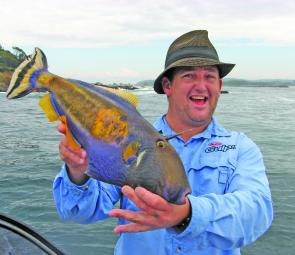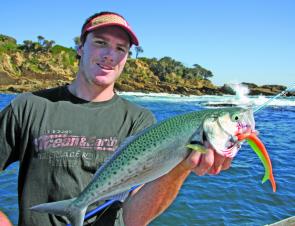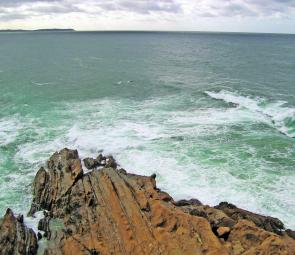The car heater growled as fingers hovered close to all outlets. It’s Spring now, but the Winter chill lurks in the morning. Dribbling noses, cold cheeks, thank god for the hot fishing or you wouldn’t get out of bed!
Arriving at our first battleground, I unglove a hand damaged from the crab-gathering session the day before. The sting of crab juice on the open wounds is a minor irritation compared with the frostbite now setting in.
The crab bait flutters to the seabed, where it washes across boulders dotted with chitons, limpets and kelp. My line slackens and comes taut with the rhythm of the boat rising and falling on the swell and backwash.
Schooling sweep and yellowtail darting around the berley bucket distract me as my rod tip takes a sudden jerk toward the ocean. The unmistakable tap-tap-CRUNCH goes right through to my thawing bones as my rod arcs into the icy sea.
Even with near lock-up drag and two thumbs on the spool, line continues to run from the reel as the blue beast below hits another cog and puts more hurt on the reel’s gearing.
My thumbs sizzle as the powerful run comes to a sudden halt as my opponent finds a frond of kelp but I manage to snig my prize clear and begin to muscle him back to the boat.
It seems the beast has spent its energy but I know my advantage is temporary. True to type, when he sees the boat he plunges hard towards the bottom but I hold tight and break his will. Spiralling up comes a blue brilliance; it threshes as it fills the Environet.
Cradling this beautiful fish, I struggle to maintain a smile for a photo before I slide the big boy back into the briny and watch him glide gracefully over a cunje-encrusted pinnacle.
Reasonably common on coastal reefs, the EBG (eastern blue groper) has become an iconic species in NSW and is now the State fish emblem.
Best recognised by their prominent lips and brilliant blue flanks, displayed by male specimens only, these fish are sheer muscle when attached to a fishing line.
They are the second-largest of the wrasse family (Labridae), with their kissing cousins the western blue groper the largest.
EBGs can grow to 1m, with the heaviest recorded weighing 16kg. Most blueys average around 8kg. Although not huge fish, they make up for it with low-down and dirty pulling power!
EBGs were a heavy target for spearfishers during the 1960s and ’70s, their docile and inquisitive nature making them easy targets. Their handsome appearance and exceptional eating qualities rocketed them to the top of the spearfishers’ hit list.
Declining numbers led to a total capture ban for around 15 years and today anglers can keep a limit of two. It remains illegal to spear them.
There’s a minimum legal length of 30cm with only one of your two permitted fish allowed to measure 60cm or more.
The ‘big blue’ is the dominant male and the squadron of smaller brown or red groper are females. The female reaches sexual maturity between 24cm and 34cm, while the sex change into a blue male can occur around 60cm.
One blue will dominate his particular domain, generally a pebbly gutter or hole close to a wash zone, gathering a harem of around 10 females. If this male dies, is captured or simply moves on, the largest brown transforms into a male and turns blue.
The majority of browns weigh 2kg to 3kg, with the dominant blue 6kg to 10kg. However, if those browns range from 4kg to 7 kg, then you’re in for a real treat when Mr Big Blue Truck decides to jump on the end of your line!
Crabs, cunjevoi, prawns and squid are great groper bait. Crabs and cunje can be collected on most rocky foreshores at low tide. Gather crabs by hand and cut cunje with a knife to access the purple flesh inside.
Crabs and cunje are my preferred baits, but check marine park charts to ensure you’re not collecting from a no-take zone.
Try to anchor on broken ground of weed and gravel in safe water adjacent to a wash zone, and not too close to hard structure. You don’t want to give these steam trains a sniff of a hidey-hole once hooked.
My theory is to berley them away from their lairs with sea urchins, cunje tunics and stale bread. Hook them out of their domain and you just may stand a chance of stopping them.
It’s real white-knuckle fishing: If you give them an inch of line the fight could end as quickly as it began.
I fish for most of my groper from a boat, as it is more productive and I can fish a few locations if they’re not biting in one spot.
My standard EBG machinery is a medium-sized overhead reel spooled with 50lb mono or braid on a 10kg to 15kg rod. The rod sounds light for the job but a soft rod seldom pulls hooks and has enough give in the tip to use as a bite indicator.
The main line tied to a solid brass ring with 20cm of 24kg mono from the ring to a 4/0 Mustad Big Gun hook. Tie a 50cm sinker dropper off the ring on 9lb mono, it’s designed to break away easily if snagged. Use just enough weight to hold your offering close to the sea bed.
The bites are mostly jolting thuds but subtle nips can also spell groper. The trick to hooking them is to lower the rod tip to allow the bait to suspend, rather than jerk up and down with swell motion.
When you’re confident the groper has devoured your offering, a gentle lift of the rod is all that’s required to set the hook.
By-catch while dangling a crab for a groper can be very tasty and welcome. Eastern rock blackfish, (black drummer or pigs) leatherjackets, bream and snapper all show up in your berley trail and willingly eat groper baits.
Fishing from the boat gives you the advantage of heaving fish away from the stones, rather than dragging fish into them.
Another option in this environment is the fantastic salmon fishing. I’ve had countless ‘dud’ groper sessions saved by a hot salmon-spinning bonanza. So remember to pack a spin rod and a few slugs, poppers and soft plastics.
The ‘uninvited’ guests are wirrah cod (aka boots), kelp fish, pike, Maori wrasse and of course, green moray eels.
I love catching groper but limit my encounters. Big groper are slow growing and can be susceptible to fishing pressure. They are fantastic eating but I rarely take one for the table.
I believe releasing them for the future is a good insurance policy to help maintain this reborn ‘white-knuckle’ fishery.
Facts
GROPER TIPS
• Spend the day before gathering fresh bait and burley
• Use extra-strong hooks and terminals; prefer solid rings to swivels
• Use the lightest sinker you can.
• Select a strong rod with a soft tip
• It’s tempting to fish light but even the small ones go hard!
• Lock up or screw down your drag
• If you lose a groper, the bite will shut down. Try moving or wait 30 minutes
• The best bite is the last hour of the run-up tide.
• If you intend to release your catch, minimise handling to avoid stressing the fish
• Fish for the future – catch, photograph and be proud as you watch them swim away
• Grab a Saltwater Guide and marine park charts

The author had barely enough energy to smile after tangling with this 10.4kg bluey, which was promptly released.

Kyle Burnell found this average brown (female) groper a real handful. Even ‘small’ groper pull exceptionally hard.

The author’s wife Trudi displays a crackin’ black drummer as groper by-catch.

Daniel Badullovich was stoked with his big leatherjacket.

It pays to have a soft plastic rigged and ready. Tom Hilyear seized the opportunity to cast at a school of salmon.

Prime groper country. Safely anchoring in deeper water close to wash zone puts you right in the ballpark.




